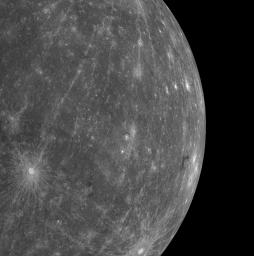
|
What a Difference a Week Can Make
- Click the image above for a larger view
- Full-Res JPEG (1018 x 1024) (126.3 kB)
- Full-Res TIFF (1018 x 1024) (1.0 MB)
Caption:
One week ago, no spacecraft had ever seen the majority of the surface visible in this image. Today, one week after MESSENGER's successful second Mercury flyby, about 95% of Mercury's surface has been viewed by spacecraft, resulting in nearly global spacecraft imaging coverage of Mercury's surface for the first time. This WAC image is just one of 99 in a set of 3 columns by 3 rows by 11 color filters that is being combined into a color mosaic of the departing planet. Kuiper crater ( PIA11355 ), with its bright ejecta rays, is visible on the left edge of the image and was seen by Mariner 10, but most of the terrain east of Kuiper was not. A newly imaged crater with an unusual halo of dark material ( PIA11357 ) is visible at about the same latitude but toward Mercury's limb. The long, bright rays that can be seen extending across the surface emanate from a crater just north of this image ( PIA11356 ).
Date Acquired:
October 6, 2008
Image Mission Elapsed Time (MET):
131772818
Instrument:
Wide Angle Camera (WAC) of the Mercury Dual Imaging System (MDIS)
WAC Filter:
1 (700 nanometers)
Resolution:
2.6 kilometers/pixel (1.6 miles/pixel)
Scale:
The left side of the image is about 2,700 kilometers tall (1,700 miles)
Spacecraft Altitude:
15,000 kilometers (9,300 miles)
Background Info:
These images are from MESSENGER, a NASA Discovery mission to conduct the first orbital study of the innermost planet, Mercury. For information regarding the use of images, see the MESSENGER image use policy .
Cataloging Keywords:
| Name | Value | Additional Values |
|---|---|---|
| Target | Mercury | |
| System | ||
| Target Type | Planet | |
| Mission | MESSENGER | Mariner |
| Instrument Host | MESSENGER | Mariner 10 |
| Host Type | Orbiter | Flyby Spacecraft |
| Instrument | Mercury Dual Imaging System (MDIS) | |
| Detector | Wide Angle Camera (WAC) | |
| Extra Keywords | Crater, Grayscale | |
| Acquisition Date | ||
| Release Date | 2008-10-13 | |
| Date in Caption | 2008-10-06 | |
| Image Credit | NASA/Johns Hopkins University Applied Physics Laboratory/Carnegie Institution of Washington | |
| Source | photojournal.jpl.nasa.gov/catalog/PIA11363 | |
| Identifier | PIA11363 | |
